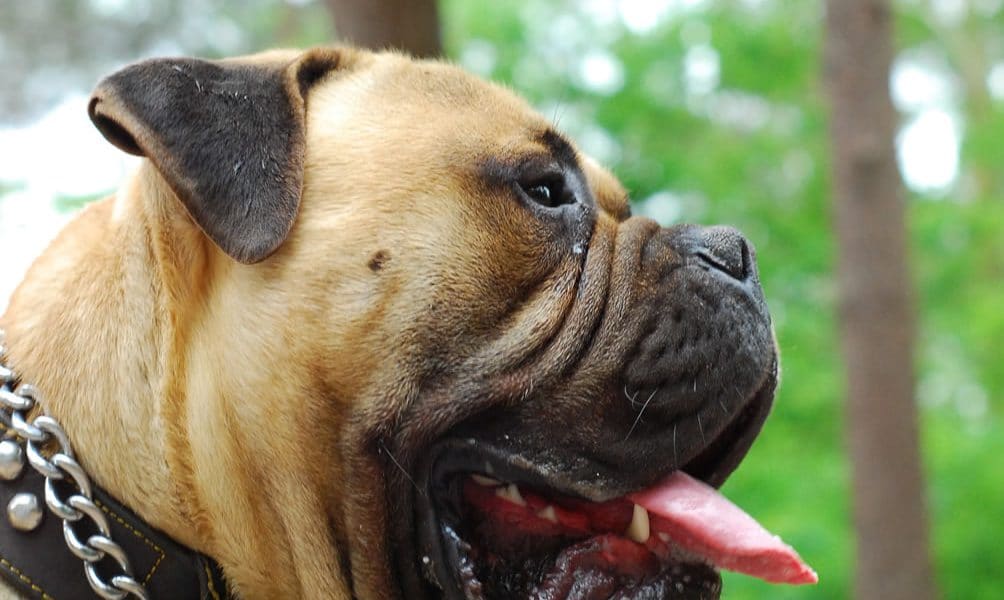 Bullmastiffs are a relatively new breed, dating back to the mid 18th century. The breed was created by crossing Mastiffs with Bulldogs (obviously the makers of this breed weren’t very creative when it came to names). These dogs were prized by gamekeepers for their threatening looks and fierce reputation. The dark brindle colours of their coats made them very useful for catching poachers at night. When an intruder was spotted, they would hunt them down and tackle them, but they were taught never to bite.
Bullmastiffs are a relatively new breed, dating back to the mid 18th century. The breed was created by crossing Mastiffs with Bulldogs (obviously the makers of this breed weren’t very creative when it came to names). These dogs were prized by gamekeepers for their threatening looks and fierce reputation. The dark brindle colours of their coats made them very useful for catching poachers at night. When an intruder was spotted, they would hunt them down and tackle them, but they were taught never to bite.
As time went on the breed began to be utilised less by game keepers. Instead, they were used by hunters and policemen. The Diamond Society of South Africa used Bullmastiffs quite often as guard dogs. Nowadays, these dogs have become a member of many happy families.
It’s easy to imagine why Bullmastiff made such good guard dogs – they’re huge! Males stand from 63 to 69 centimetres at the withers and weigh around 55kg. Females are not much smaller. They are solidly built but not cumbersome, with a broad, wrinkled skull and a deep muzzle. Their ears are triangular shaped and lay close to the cheeks. Their tails are thick at the base and taper back into a curl.
The coats of this breed are short and rough. These dogs are brindle, red, or fawn. Usually the colour of the muzzle is a little bit darker than the rest of the body. Not much grooming is required, and generally shedding is not a big issue. When grooming, you’ll want to keep an eye on their feet. Because of the weight they carry, Bullmastiffs’ paws may have some problems.
The Bullmastiff is extremely loyal and loving with his family. He will go to great lengths to protect them if danger is sensed. If an intruder dares enter a house where a Bullmastiff is on guard, he can expect to be tackled and held down until reinforcements arrive. This breed is very gentle and accepting with children, but because of their large size they may accidentally knock over smaller tots while playing.
 This breed requires an owner who can act as the pack leader. Since Bullmastiffs tend to be a more dominant dog, it’s crucial that they understand that their owner is the boss. If not, well, how easy do you think it would be to control 55 kilograms of speed and muscle while out on a walk? Obedience training is an absolute must while your Bullmastiff is a puppy – this way you can teach him how to behave while he is still small enough to handle.
This breed requires an owner who can act as the pack leader. Since Bullmastiffs tend to be a more dominant dog, it’s crucial that they understand that their owner is the boss. If not, well, how easy do you think it would be to control 55 kilograms of speed and muscle while out on a walk? Obedience training is an absolute must while your Bullmastiff is a puppy – this way you can teach him how to behave while he is still small enough to handle.
These dogs are prone to elbow and hip dysplasia, eyelid problems and bloat. Keep an eye on how much they are eating, as they are able to gain an unhealthy amount of weight very quickly. The average lifespan of this breed is eight to ten years.
Bullmastiffs are definitely people dogs. They just love being around an affectionate and supportive family. The worst thing you could do to one of these dogs is banish him to a kennel or an empty yard. They need to have a walk every day to get some of their energy out. A good romp in the yard or park can also be a lot of fun, provided that the dog is trained well enough to know when to stop.
Generally very sweet natured, Bullmastiffs should get along well with other household pets, especially if they are introduced to them at a young age. Usually they get along just fine with other dogs, but don’t be surprised if your male Bullmastiff doesn’t get on as well with other males as you would like.


